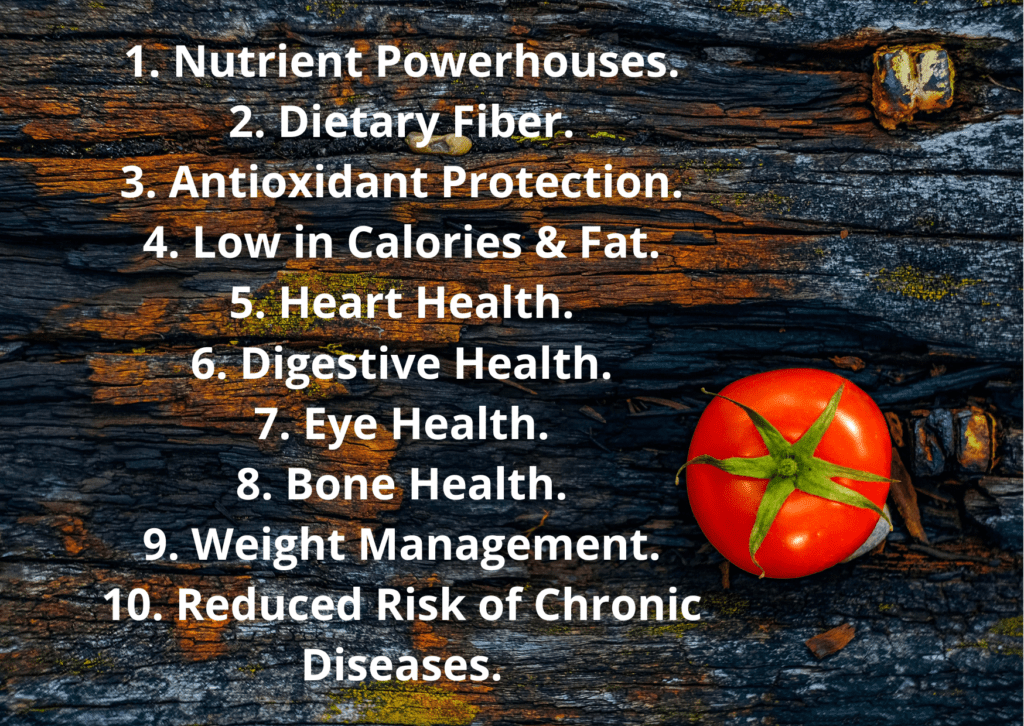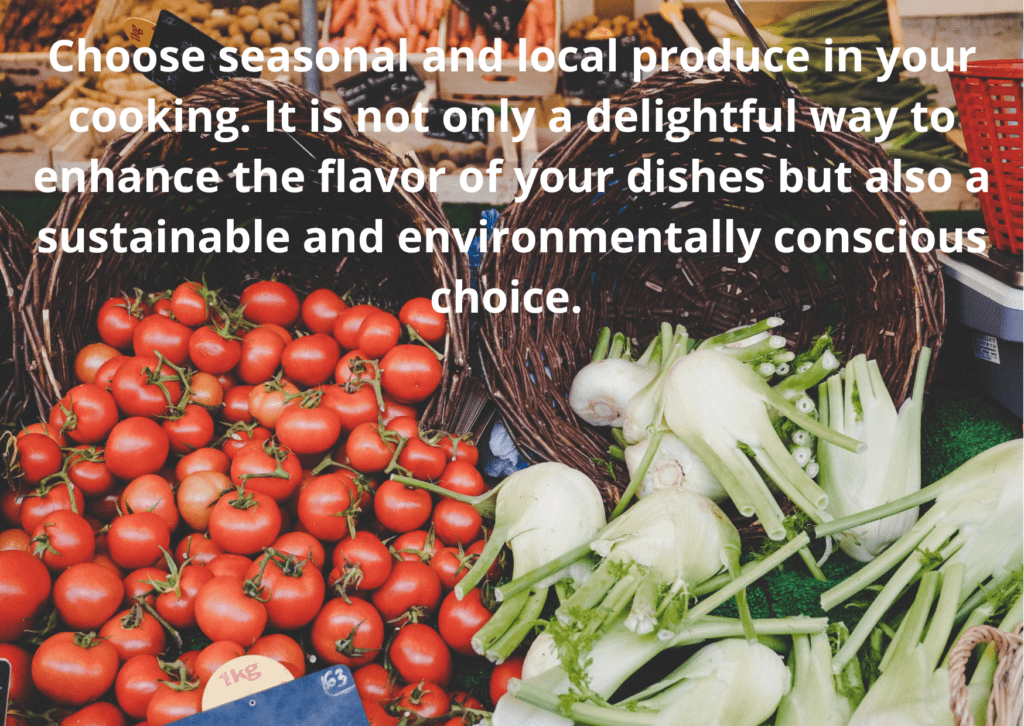Vegetables are usually on the side of your plate, but they’re super healthy. What’s exciting is that they can also be the star of your meal. I’ll teach you how to make veggies amazing – from picking the best ones to using spices, cooking tricks, and combining them with other tasty things.
Let’s explore how to make vegetables taste great and make your healthy eating even better.
10 Amazing Health Benefits of Vegetables
Using a Rainbow Variety of Vegetables
Different colors of vegetables often indicate different nutrient profiles. Each color group in vegetables contains unique antioxidants.
Incorporating a rainbow of vegetables into your diet ensures that you’re not only benefiting from a broad spectrum of nutrients but also adding vibrancy, flavor, and excitement to your meals. So, the next time you’re at the grocery store or planning your meals, think of including a variety of colorful vegetables to maximize their health benefits.
Red Vegetables:
Rich in Antioxidants: Red vegetables like tomatoes, red peppers, and beets are packed with antioxidants like lycopene and anthocyanins. Lycopene, in particular, is known for its potential in reducing the risk of certain cancers and promoting heart health. Scientific studies have shown that lycopene may help reduce the risk of prostate cancer and lower blood pressure.
Heart Health: The presence of lycopene and other compounds in red vegetables has been linked to reduced risk factors for heart disease. Studies have suggested that regular consumption of tomatoes, in particular, may help improve cholesterol levels and reduce the risk of cardiovascular disease.
NutriQuorum’s Red Recipes:
Cherry Tomato Salad with Feta Cheese
Hearty & Healthy: Vegetarian Borsh Recipe
Orange Vegetables:
High in Beta-Carotene: Orange vegetables such as carrots, sweet potatoes, and butternut squash are rich in beta-carotene, a type of carotenoid. Beta-carotene is converted into vitamin A in the body, essential for good vision, immune function, and skin health.
Vision Protection: Beta-carotene is known for its role in maintaining eye health. It helps prevent night blindness and may reduce the risk of age-related eye conditions like macular degeneration. Scientific studies have confirmed the positive impact of beta-carotene on eye health.
NutriQuorum’s Orange Recipes:
Roasted Butternut Squash with Kale
Pumpkin Soup with Secret Ingredient
Yellow Vegetables:
Vitamin C: Yellow vegetables like yellow bell peppers and corn are excellent sources of vitamin C, which is crucial for the immune system, skin health, and wound healing. Vitamin C is also a powerful antioxidant that fights free radicals.
Collagen Production: Vitamin C in yellow vegetables plays a key role in collagen production, contributing to healthy skin, tendons, and blood vessels. Scientific research supports the link between vitamin C intake and collagen formation.
NutriQuorum’s Yellow Recipes:
Wraps with Beans & Bell Peppers
Green Vegetables:
Rich in Fiber: Green vegetables like spinach, broccoli, and kale are high in dietary fiber, which aids digestion, promotes a feeling of fullness, and helps manage weight. Fiber also supports a healthy gut microbiome.
Abundant in Chlorophyll: The green pigment chlorophyll in these vegetables has been associated with detoxification and antioxidant effects. Studies suggest that chlorophyll may help reduce the risk of certain cancers and protect against harmful compounds.
Bone Health: Green vegetables are often a good source of vitamin K, which is essential for bone health. Vitamin K plays a role in calcium absorption and bone mineralization. Scientific evidence supports the connection between vitamin K intake and improved bone density.
Reduced Risk of Chronic Diseases: Numerous studies have shown that a diet rich in green vegetables is associated with a reduced risk of chronic diseases like heart disease, diabetes, and certain cancers. The antioxidants, vitamins, and minerals in green vegetables contribute to this protective effect.
NutriQuorum’s Green Recipes:
The Best Zucchini from My Childhood
Green Salad with a Blueberry Twist
Bowl of Goodness: Salmon with Broccoli & Shiitake
Purple Vegetables:
Anthocyanins: Purple vegetables owe their vibrant color to a group of powerful antioxidants called anthocyanins.
Antioxidant Protection: Anthocyanins in purple vegetables, such as purple cabbage, eggplant, red onions, and purple sweet potatoes, help protect cells from oxidative damage caused by free radicals. Oxidative stress is linked to various chronic diseases, including cancer and heart disease.
Heart Health: Studies have suggested that anthocyanins may reduce the risk of heart disease by improving blood vessel function and lowering blood pressure. Consuming purple vegetables as part of a heart-healthy diet can contribute to these benefits.
Cognitive Function: Some research indicates that anthocyanins may support cognitive function and brain health. They are believed to have neuroprotective properties and may help reduce the risk of age-related cognitive decline.
Anti-Inflammatory Effects: Purple vegetables may help combat inflammation in the body. Chronic inflammation is associated with various health problems, and the anti-inflammatory properties of anthocyanins can contribute to overall well-being.
NutriQuorum’s Purple Recipes:
Simple Marinated Eggplant Appetizer
Pickled Rred Onions in 2 Easy Steps

10 Foundational Aspects of Flavor in Cooking Vegetables
Understanding these foundational elements of flavor and experimenting with them in your cooking will help you create dishes that are super delicious!
- Ingredients: The quality and freshness of the ingredients you use play a fundamental role in flavor. Fresh, high-quality ingredients often have more intense and appealing flavors. For example, ripe tomatoes, just-picked herbs, and well-marbled meats can elevate the taste of your dishes.
- Seasoning: Proper seasoning with salt and pepper enhances the natural flavors of ingredients. Salt, in particular, is a crucial seasoning that helps balance and intensify flavors. Need more advises about seasoning? Read the article Salt in Your Recipes: From Pinch to Perfection.
- Herbs and Spices: Herbs and spices add depth and complexity to dishes. Experimenting with different herbs and spices allows you to create unique flavor profiles. Find out more tips in the article Culinary Medicine: The Healing Power of Spices.
- Fat: Cooking fats like butter, olive oil, and animal fats carry and enhance flavors. They can also add richness and creaminess to dishes. The choice of fat can influence the overall flavor, so selecting the right one for your recipe is important.
- Acidity: Acidic ingredients like citrus juice, vinegar, and wine can brighten and balance flavors. They cut through richness and add a refreshing tang to dishes.
- Texture: Texture is a crucial aspect of the dining experience. It can impact how we perceive flavor. The contrast between crispy, crunchy, and tender elements in a dish can make it more enjoyable.
- Cooking Techniques: Different cooking techniques, such as roasting, grilling, sautéing, and braising, can impart distinct flavors and textures to ingredients. Mastering these techniques allows you to control and develop the desired flavors in your dishes.
- Layering: Building layers of flavor involves adding ingredients at different stages of cooking. For example, sautéing onions and garlic before adding tomatoes and herbs can create a deeper and more complex flavor profile.
- Taste Testing: Taste testing throughout the cooking process is crucial. Adjusting seasonings, acidity, and other elements as you go ensures that the final dish is perfectly balanced and flavorful.
- Time: Some dishes benefit from slow, gradual cooking that allows flavors to meld and develop over time. Slow-cooked stews and braises, for example, often have more concentrated and complex flavors.
Flavor-Boosting Ingredients
Flavor-boosting ingredients are the secret weapons in the kitchen that can take your dishes from ordinary to extraordinary. These ingredients add depth, richness, and complexity to your food.
Garlic – is a versatile flavor enhancer that adds a pungent, savory taste to dishes. Whether minced, crushed, or roasted, it can elevate the flavor of soups, sauces, stir-fries, and more.
Onions – particularly when sautéed or caramelized, provide a sweet and aromatic base for many recipes.
Fresh Herbs – basil, parsley, cilantro, thyme, and rosemary infuse dishes with fresh, vibrant flavors. For more tips, check out my article The Art of Pairing Fresh Herbs with Dishes.
Citrus – lemon, lime, and orange zest or juice add a burst of bright acidity and refreshing aroma to both sweet and savory dishes.
Soy Sauce – is prized for its salty umami flavor. It can be used to enhance the savory notes in marinades, dressings, and stir-fries.
Fish Sauce – is a potent flavor enhancer. It adds a salty, savory, and slightly funky depth to dishes like curries and soups.
Vinegars – such as balsamic, red wine, and apple cider vinegar, provide acidity and tang to salads, sauces, and marinades.
Miso Paste – is rich in umami and can be used in soups, dressings, and glazes to impart a deep, savory flavor. It’s a staple in Japanese cuisine.
Stocks and Broths – Homemade or store-bought stocks and broths, whether vegetable, chicken, or beef, are the foundations of many flavorful sauces, soups, and stews. Grab the Homemade Vegetable Broth Recipe here
Spices – cumin, paprika, cinnamon, and curry powder can add warmth, depth, and complexity to dishes. Toasting them briefly before use can intensify their flavors.
Chili Peppers – fresh or dried chili peppers add heat and complexity to dishes. They come in various levels of spiciness, allowing you to control the heat in your cooking.
Fresh Ginger – provides a zesty, slightly spicy flavor and a pleasant aroma.
Parmesan and Hard Cheeses – can add a salty, nutty flavor to pasta, risotto, and salads.
Nuts – almonds, walnuts, and pine nuts offer a satisfying crunch and a rich, nutty flavor that can enhance your vegetable dishes.
Wine and Alcohol – spirits like brandy or whiskey can add depth and complexity to sauces and braised dishes. The alcohol often cooks off, leaving behind rich flavors.
Tips for Picky Eaters
Dealing with picky eaters, whether they are children or adults, can be challenging, but with patience and creativity, you can encourage a more varied and nutritious diet.
Lead by Example: Be a role model by demonstrating a positive attitude towards trying new foods. Show that you enjoy a variety of foods, including fruits and vegetables.
Involve Them in Meal Planning: Let picky eaters have a say in what’s on the menu. Include them in meal planning and grocery shopping, allowing them to choose some ingredients or dishes they’d like to try.
Cook Together: Get your picky eater involved in the kitchen. When they help prepare a meal, they may be more willing to taste the final product.
Keep It Small: Serve new or less-favored foods in small portions as part of a meal rather than making them the main course. This reduces the pressure to eat a large quantity.
Offer Variety: Provide a variety of foods and flavors on the table. A diverse selection makes it more likely that your picky eater will find something they like.
Make It Fun: Present food in creative and appealing ways. Use cookie cutters to make fun shapes, arrange vegetables in a colorful salad, or create “build-your-own” style dishes like tacos or sandwiches.
Be Patient and Persistent: Understand that it may take several exposures to a new food before a picky eater is willing to try it. Be patient and avoid making mealtimes stressful.
Don’t Force It: Avoid pressuring or coercing your picky eater to try new foods. This can lead to resistance and negative associations with those foods.
Positive Reinforcement: Praise and reward your picky eater when they try new foods or make an effort to eat a balanced meal. Offer positive feedback and encouragement.
Mix Familiar and New: Pair unfamiliar or disliked foods with familiar favorites. This can make the new food seem less intimidating.
Hidden Veggies: Sneak vegetables into dishes by blending them into sauces, soups, or smoothies. For example, add spinach to a fruit smoothie or puree carrots into pasta sauce.
Respect Their Preferences: While encouraging exploration, respect your picky eater’s food preferences to a certain extent. If they genuinely dislike a particular food, don’t force them to eat it.
Set a Routine: Establish regular meal and snack times. A consistent schedule can help picky eaters feel more comfortable and open to trying new foods.
Limit Unhealthy Options: Minimize the availability of highly processed and unhealthy foods at home. If they’re not readily available, picky eaters may be more inclined to try healthier options.
Seek Professional Help: If your picky eater’s limited diet is causing nutritional concerns or significant stress, consider consulting a pediatrician, dietitian, or therapist who specializes in feeding issues.
Thank you for joining me on this journey of Veggie Magic. Together, we can create healthier, more vibrant, and tastier meals that nourish our bodies and delight our palates. Here’s to a future filled with colorful, flavorful, and fulfilling vegetable adventures.
Happy cooking!









